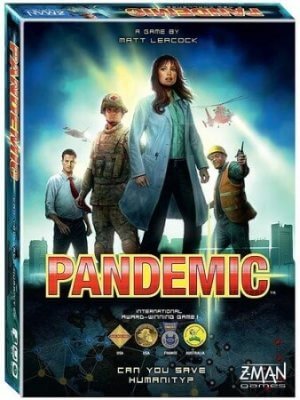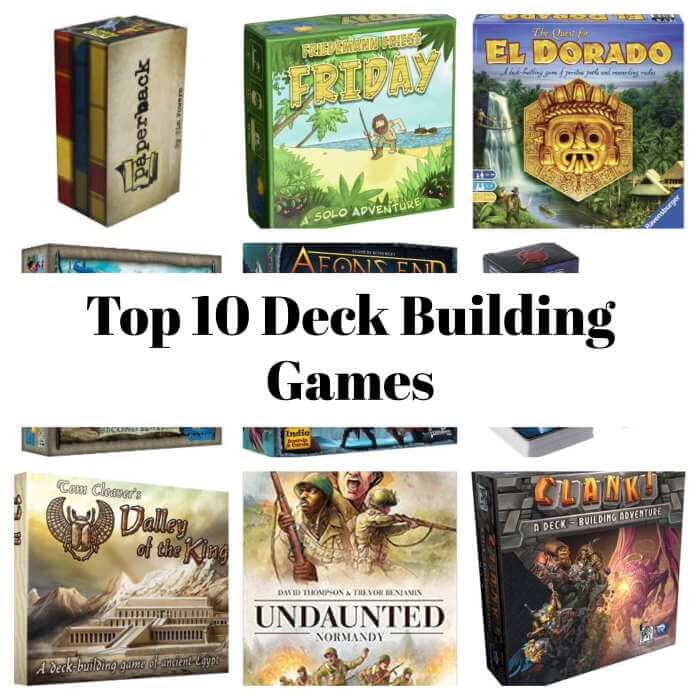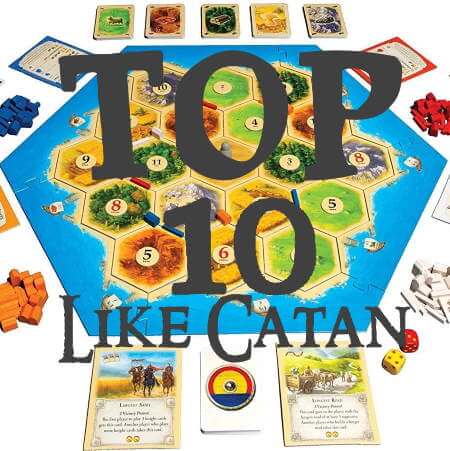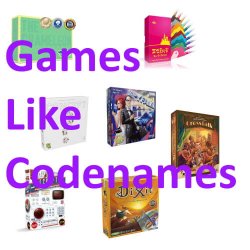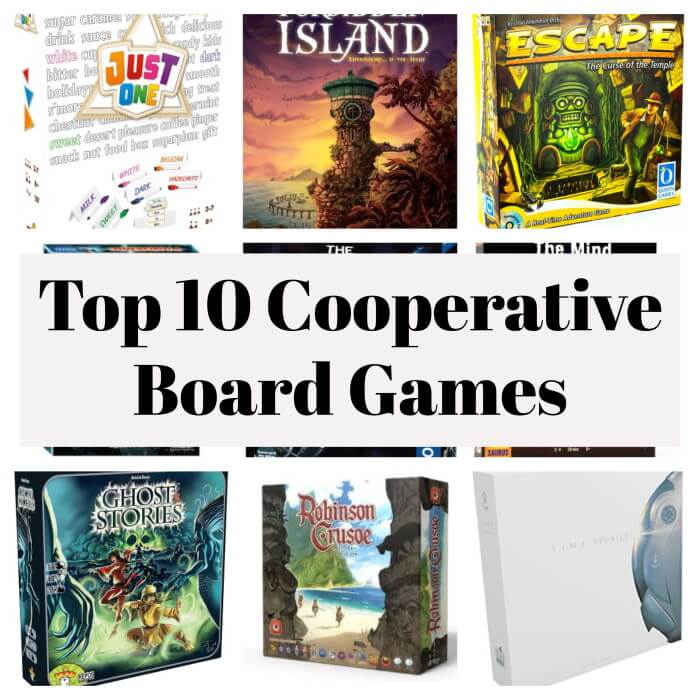
Competing with friends around the table with a board game can be a lot of fun – taking moves to hurt your opponents in order to sneak away with a victory in the last possible second, only to leave your friends infuriated as to how they didn’t see it coming.
But a game doesn’t have to be competitive in nature order to be exciting or tension-filled.
Cooperative board games bring players together as they work to achieve a common victory against a threat. Typically (but not always), cooperative games have some sort of AI or automa systems that players struggle to fight off.
There are many benefits to cooperative games, such as the fact that they can be easier to teach than competitive games due to the fact that information is shared. Also, they can offer a fun and rewarding gaming experience to players who don’t enjoy competition in games.
Here are 10 cooperative games worth checking out.
1. Pandemic – Fight Against Disease to Save the World
While the theme of a pandemic may not seem appealing given the current global crisis, the game Pandemic offers the chance to save humanity and fight against diseases that are quickly spreading around the globe.
Pandemic is easily one of the most popular cooperative board games available, having won multiple awards and consistently appearing in many gamers’ top board game lists.
Pandemic is easily one of the most popular cooperative board games available, having won multiple awards.
Pandemic at a Glance
| Game Type Cooperative, Medical Theme, Action Points, Point to Point Movement, Variable Player Powers | Play Time 45 mins | Skill/Complexity (2.5 - 5) Light - Medium |
| Age 8+ | Publisher(s) Z-Man Games | Published 2008 |
| Categories Strategy Family | Players 2 - 4 | Rules Manual Official Rules PDF |
| Our Rating 9.3/10 | Cost $39.99 |
While there are multiple iterations of the Pandemic game system – including the notable Pandemic Legacy series – we will focus on the core base game here as it will give you an idea for its main mechanisms.
Pandemic, designed by Matt Leacock, is a game where players are members of a disease control team who must eradicate four diseases before it’s too late. The main idea of the game is that players, each equipped with special abilities, take turns moving around the board, removing disease cubes, building research stations, discovering cures for diseases by discarding 4 matching cards of a color, and then attempting to eradicate the diseases by removing all disease cubes from the board.
A really interesting aspect of Pandemic is the way that disease cubes spread around the board. At the end of a player’s turn, they draw cards from an infection deck equal to the current infection rate. For each card drawn, disease cubes are placed on the indicated city on the board. If a cube needs to be placed on a city where there are already 3 disease cubes present, then an outbreak occurs in which an additional disease cube is placed on each adjacent city. This can cause large-scale chain reactions that can suddenly change the game, and that tension feels very thematic indeed.
Pandemic is a game that could potentially work well as a gateway-style game for people who have never played games before. The rules are not difficult to grasp, and the theme especially makes the choices on a player’s turn intuitive.
There are multiple expansions available for the game that can change things up, and if you are looking for an extra-unique experience, then Pandemic Legacy may be worth looking into.
If you prefer a game that is similar in terms of mechanisms but even more light-weight and accessible (and better-suited for children), then the next game on the list, Forbidden Island, may be a good choice for you.
2. Forbidden Island – Discover Treasure and Escape from a Sinking Island
You and up to three other adventurers are on a mission to discover and retrieve four sacred artifacts from a forbidden island, but you must do so before it’s too late. With an ancient curse cast onto the island, your presence is causing it to sink. Will you be able to snag all four artifacts and get everyone back to the helicopter pad safely and in time before the island, or a path to escape, vanishes into the oceanic void?
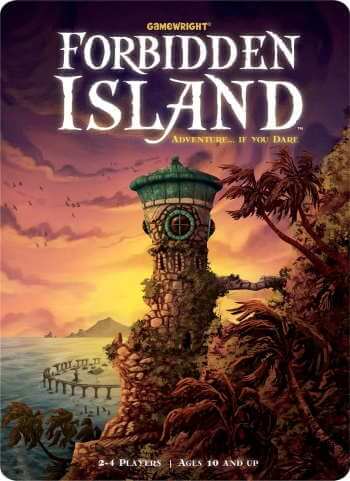
Forbidden Island at a Glance
| Game Type Fantasy, Adventure, Action Points, Cooperative, Grid Movement, Map Reduction, Modular Board Pick-up and Deliver, Solo/Solitaire Game Variable Player Powers | Play Time 30 mins | Skill/Complexity (2 - 5) Light |
| Age 10+ | Publisher(s) Gamewright and Others | Published 2010 |
| Categories Family | Players 1 - 4 | Cost $19.99 approx |
| Our Rating 8/10 |
In a game of Forbidden Island, designed by Matt Leacock, players each take on the unique role of adventurers, each equipped with special abilities to help them and their teammates along the journey. Over the course of the game, players take turns moving around island tiles, collecting treasure cards, sharing treasure cards with other players, capturing treasures by discarding four matching treasure cards, and shoring up island tiles. Players also have to draw flood cards at the end of their turn equal to the current water meter level, which cause island tiles to flood. If a flood card is ever drawn for a tile that is currently flooded, that tile is removed from the game permanently. In order to win the game, all players must escape via the helicopter pad with a “Helicopter Lift” card after having captured all four treasures.
Forbidden Island is definitely on the light-end of the game weight spectrum, with a weight rating of 1.74 on BoardGameGeek.
Being designed by the same designer as Pandemic, the game shares many of the same mechanisms, and has often been referred to as a light version of Pandemic. For this reason, Forbidden Island works very well as a good introduction to the world of modern board games for players who have not played many games. It also is an excellent family game, or even for hobby board gamers who want a quick, light game to play when they aren’t in the mood for something more involved or lengthy.
3. Robinson Crusoe: Adventures on the Cursed Island – A Fairly Heavy Game of Survival
Many games in the cooperative game genre can work very well as gateway-style games for people who don’t play many board games, given the fact that many of these games often work well with the “learn-as-you-go” teaching format.
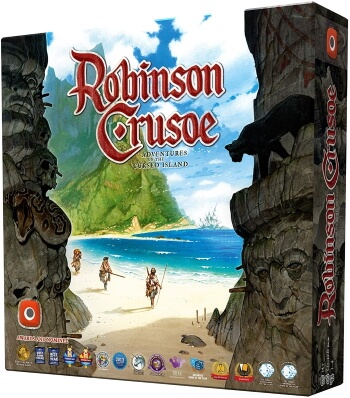
But what about gamers who are looking for a game that is deep, decently-heavy, and challenging? If this sounds like what you are currently looking for, then Robinson Crusoe: Adventures on the Cursed Island, designed by Ignacy Trzewiczek, may be one to pay attention to.
But what about gamers who are looking for a game that is deep, decently-heavy, and challenging?
Robinson Crusoe at a Glance
| Game Type Thematic, Action Queue, Cooperative, Dice Rolling, Hexagon Grid, Adventure, Fighting, Novel-Based, Solitaire, Worker Placement | Play Time 60 - 120 mins | Skill/Complexity (4 - 5) Medium - Heavy |
| Age 14+ | Publisher(s) Portal Games and others | Published 2012 |
| Categories Strategy | Players 1 - 4 | Cost $49.99 approx |
| Our Rating 9/10 |
As survivors on an island, players in Robinson Crusoe must work together and use their unique player abilities to survive the harsh elements, cruel twists of fate, and declining morale among the group. They must build tools and shelter, find food, hunt, and explore the island as they try work toward completing the objective required by their current game scenario. With many threats to deal with, players struggle throughout the game to maintain health, and if one player dies, all players lose the game.
One really interesting mechanism found in the game Robinson Crusoe are the adventure cards. When drawn, adventure cards give the players a scenario and then ask players to make a decision – whether to discard the card, or to gain a benefit and then shuffle the card into the event card deck. When that adventure card is drawn later on, the players read the bottom half of the card, which is a consequence for the decision they made earlier in the game. This adds a thematic element to the gameplay experience and highlights the importance of player’s decisions and unintended consequences of those decisions.
Robinson Crusoe, while very thematic, has a fairly complicated set of rules. For this reason, it’s probably a good game to play if at least one player at the table knows the rules very well, as there is quite a bit to keep track of. That being said, it can offer a very memorable gaming experience, and one that you will likely talk about with your friends for some time to come.
4. Ghost Stories – A Tower-Defense-Style Game
In Ghost Stories, designed by Antoine Bauza, players take on the role of Taoist priests as they ward off the forces of evil from crossing over into their beloved village. Life in the village for much time now has been nothing more than an illusion of peace, for the villagers have long-forgotten that buried within the cemetery is an urn containing the cursed ashes of the Lord of the Nine Hells – Wu Feng.
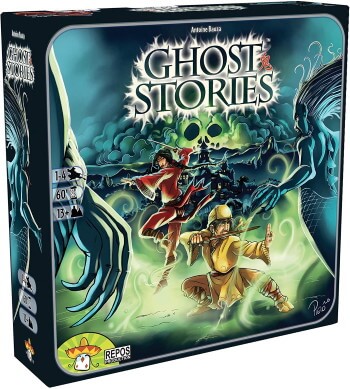
Ghost Stories at a Glance
| Game Type Thematic, Fantasy, Cooperative, Dice Rolling, Grid Movement, Modular Board, Move Through Deck, Solo/Solitaire Game | Play Time 60 mins | Skill/Complexity (3 - 5) Medium |
| Age 12+ | Publisher(s) Repos Production, Asmodee | Published 2008 |
| Categories Strategy | Players 1 - 4 | Cost $39.99 |
| Our Rating 8.8/10 |
Equipped with special abilities, players in Ghost Stories must fight the continual onslaught of maleficent entities. The ultimate goal as a group is to survive a deck of ghost cards, and ultimately defeat the Wu Feng incantation randomly selected for the current game when he appears toward the end of the ghost deck. Players take turns in the game moving around the village, using special abilities of village tiles, and performing combat against ghosts that continuously move closer to the village. If a ghost ever reaches the village, then the adjacent village tile is flipped over and players lose access to its special ability. Players lose the game if all characters are dead, three village tiles become haunted, or the last ghost card is drawn when Wu Feng remains undefeated.
If you like games that have a tower-defense feel to them, then Ghost Stories is one that you may very much enjoy. As players fight to keep the central village tiles free of ghosts that are continually bombarding its borders, it is definitely a challenge to overcome.
If you like games that have a tower-defense feel to them, then Ghost Stories is one that you may very much enjoy.
While the game includes four modes of difficulty – initiation, normal, nightmare, and hell – Ghost Stories is known for being a very challenging cooperative game to beat, even in initiation or normal mode. If you manage to beat Ghost Stories on hell mode, then you will have earned some serious bragging rights.
5. T.I.M.E Stories – A One-Time Playthrough Time-Travel Experience
Escape room games (i.e., games that can only be played once and offer a unique puzzle to solve) have certainly become a popular genre. One of the titles that put this style of game onto the radar, however, was T.I.M.E Stories. At the time it was released in 2015, the idea of a game that you could only play once was quite a controversial concept.
Escape room games (i.e., games that can only be played once and offer a unique puzzle to solve).
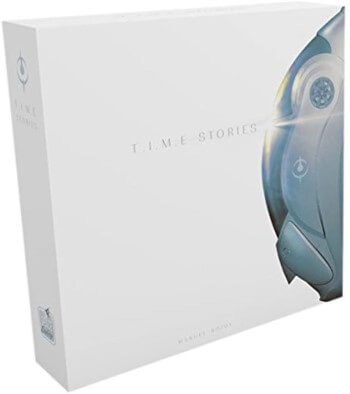
T.I.M.E Stories at a Glance
| Game Type Thematic, Science Fiction , Cooperative, Dice Rolling, Move Through Deck, Storytelling, Variable Player Powers | Play Time 90 mins | Skill/Complexity (2.7 - 5) Light - Medium |
| Age 12+ | Publisher(s) Asmodee, Space Cowboys and Others | Published 2015 |
| Categories Strategy | Players 2 - 4 | Cost $51.99 |
| Our Rating 8.9/10 |
Still, T.I.M.E Stories managed to be a very successful release and won multiple awards. With the release of many expansions, the game system managed to stay popular, and is definitely worth considering if the theme and concept of the game appeals to you.
While we can’t go over many of the details of the gameplay and scenarios to avoid spoilers, the main idea of the game is that you and up to three other players are put into the role of time travelers who are tasked with going to a certain point in time in a particular universe/reality in order to prevent temporal faults and paradoxes. To do so, you must explore, find clues, solve puzzles, and ultimately complete the mission at hand.
The base game of T.I.M.E Stories includes one scenario (Asylum), and if you wish to keep playing, you will need to purchase additional scenarios to play with the core game set. While many people have managed to play all scenarios for the game, you don’t necessarily need to play all of them to appreciate the experience it has to offer.
T.I.M.E Stories falls into the category of games that create unique and memorable experiences through its clever theme, story, and puzzles to solve. With the right group of friends, T.I.M.E Stories is a game you will likely never forget and one that you may easily find yourself wanting to continue playing as soon as possible.
One downside to the game is that you will likely want to continue playing the scenarios with the same group of friends to fully appreciate the story and experiences you encounter along the way. Because each scenario can take multiple hours to complete, it can be challenging to meet with the same group of friends for a period of time long enough to get through multiple scenarios.
6. The Mind – A Number Game with No Communication
One really interesting element to cooperative games is how different games approach the concept of player communication.
While players are working together to achieve a common goal, it’s not always the case that they are able to openly communicate about what cards they are holding in their hand, or what they intend to do on their turn. The Mind, designed by Wolfgang Warsch, is a game on one extreme end of the communication spectrum in that it doesn’t allow any communication between players.
A game on one extreme end of the communication spectrum in that it doesn’t allow any communication between players.
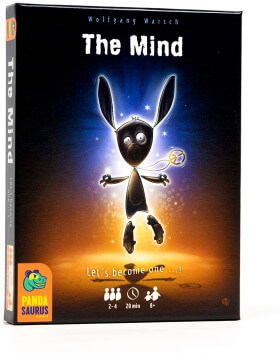
The Mind at a Glance
| Game Type Card Game, Cooperative,, Communication Limits | Play Time 15 mins | Skill/Complexity (1.2 - 5) Light |
| Age 8+ | Publisher(s) Pandasaurus Games and Others | Published 2018 |
| Categories Family / Party / Teens | Players 2 - 4 | Cost $14.99 |
| Our Rating 7.5/10 |
In The Mind, the group’s goal is to place cards held in players’ hands onto the table in ascending order without any exchanging of information. With a deck of cards numbered 1-100, players draw cards equal to the current level (they begin with level 1, and attempt to beat levels 8, 10, or 12, depending on the number of players). Then, when they feel the moment is right, they play a card from their hand onto the table. If a player holds a card in their hand lower than the card that was just played, the group loses a life (they begin the game with lives equal to the number of players). The group can also decide to play their throwing star (of which they only have one) by raising their hands, and then they can each discard their lowest-valued card from their hand and place it face-up to the side, giving all players at the table more information.
The Mind is certainly a game that can work well with groups of people who don’t normally play games, as it doesn’t have many rules to keep track of. The interesting “group mind” concept is one that many people will likely find enjoyable, and part of the fun of the game is playing with the same group over and over again as you try to hone in on your telepathic abilities.
If you are someone who doesn’t typically like cooperative games due to the alpha-gamer problem (i.e., someone telling other players what to do on their turn), you will not run into this problem with The Mind, and you may appreciate this game more than other cooperative games for this reason.
7. Escape: The Curse of the Temple – A Real-Time Dice Rolling Game
In this real-time game experience of simultaneous dice rolling, players in Escape: The Curse of the Temple must explore a temple as quickly as possible in order to discover gems, and each escape the temple – in just ten minutes.
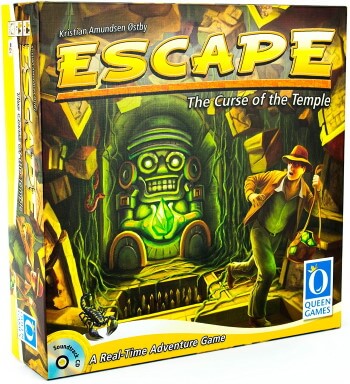
Escape: The Curse of the Temple at a Glance
| Game Type Adventure, Exploration, Cooperative,, Dice Rolling, Real-time, Modular Board, Push Your Luck, Tile Placement, Solo/Solitaire Game | Play Time 10 mins | Skill/Complexity (1.5 - 5) Light |
| Age 8+ | Publisher(s) Queen Games and Others | Published 2012 |
| Categories Family | Players 1 - 5 | Cost $59.99 |
| Our Rating 8.4/10 |
This cooperative board game, designed by Kristian Amundsen Østby, comes with a soundtrack to play that acts as both a timer for the game and a way to induce stress in its players with increasing levels of intensity.
There are no turns in a game of Escape. Once the soundtrack begins, players immediately all begin rolling dice at the same time, moving through the temple, discovering new temple tiles, and activating gems.
There are no turns in a game of Escape. Once the soundtrack begins, then players immediately all begin rolling dice.
Players begin the game with 5 dice and a certain number of gems in the gem depot depending on the number of players. In order to remove gems from the depot and place them onto the board, players must roll a certain number of keys or torches as required on a temple tile where they are currently located. Players who are on the same tile can share their dice rolls in order to meet the dice-roll requirement. If a player rolls a black mask, that die becomes locked until they roll a golden mask, which can unlock up to two black masks. Players can also use their golden masks to unlock another player’s dice if they are on the same tile.
In order to win the game, each player must escape the temple by moving to the exit chamber and then rolling keys equal to the number of gems currently in the depot plus one. Players lose the game if any player has not escaped the temple by the time the soundtrack ends at the 10-minute mark.
Escape: The Curse of the Temple is a game that’s chaotic in a good way; it’s full of energy and excitement, with a lot of fun packed into just 10 minutes. If you are a fan of real-time games, and don’t mind the stress of racing against the clock, then Escape is a game you may very well enjoy and come back to time and time again.
Given its very short game length, it’s easy to play several rounds in a row if you don’t manage to get out of the temple in time the first time around. It is also very easy to teach, and suitable for kids ages 8 and up, making it a great addition for just about any family’s game collection.
8. Spirit Island – A Unique Spin on the Colonization Theme
There are many Euro-style board games that have a theme of colonization in which players explore new land and exploit its resources in order to become wealthy and prosperous. Spirit Island, on the other hand, puts players in the opposite role of a spirits of nature who try to protect the native people of their island, the Dahan, from foreign colonizers.

| Game Type Environmental, Fantasy, Fighting, Mythology, Territory Building Area Majority/Influence, Cooperative, Hand Management | Play Time 90 - 150 mins | Skill/Complexity (4.4 - 5) Heavy |
| Age 13+ | Publisher(s) Greater Than Games and others | Published 2017 |
| Categories Strategy | Players 1 - 4 | Cost $59.99 |
| Our Rating 9.6/10 |
In Spirit Island, designed by R. Eric Reuss, players begin the game with a win condition of having to completely rid the island of invaders, which is a very difficult task to achieve. However, as the game progresses, and players manage to instill fear in the colonizers, they can reach new fear levels that make the winning conditions of the game become easier to obtain. For instance, in level 2, players must rid the board of cities and towns; in level 3, they must destroy all cities; and in level 4, they obtain a terror level (immediate) victory. In other words, instilling enough fear can be enough to win the game.
Players begin the game with a win condition of having to completely rid the island of invaders, which is a very difficult task to achieve.
What makes Spirit Island especially unique as a cooperative board game experience is exploring the different combinations of player powers, and discovering the interesting ways that certain characters can work together. The base game comes with eight different spirits, and there are currently two expansions available that include additional spirits (Spirit Island Branch & Claw includes two, and Spirit Island: Jagged Earth includes ten).
One potential negative to Spirit Island is that it is quite a complex game with a significant learning curve (it has a complexity rating of 4.01 on BoardGameGeek), and can take multiple plays to truly understand how to best utilize the spirits’ abilities. If that is something you are comfortable with, then Spirit Island can provide a rewarding and deep gaming experience with your friends.
9. Just One – A Cooperative Party Game
Many people enjoy pulling out party games at gatherings, and it’s no surprise how popular some party games have become given their entertainment value and extremely low rules overhead. Sometimes, however, the same party games can begin to feel stale with repeated plays, and it can feel refreshing to bring something new to a casual game night that you know people will enjoy.
It’s no surprise how popular some party games have become given their entertainment value and extremely low rules overhead.
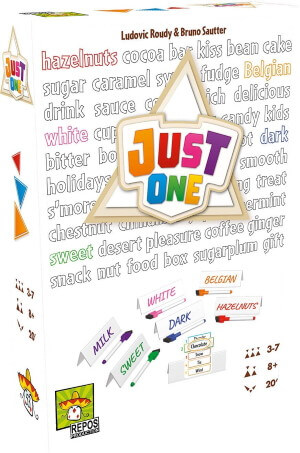
Just One at a Glance
| Game Type Cooperative,, Communication Limits | Play Time 20 mins | Skill/Complexity (1.2 - 5) Light |
| Age 8+ | Publisher(s) Repos Production and Others | Published 2018 |
| Categories Party / Word | Players 3 - 7 | Cost $19.99 |
| Our Rating 8.8/10 |
In recent years, the party game genre has broken into the hobby board game sphere, with two party game titles winning the Spiel des Jahres award in the past two years: one being Codenames, a team vs. team word game, and the other being Just One, a cooperative word game which we will highlight here.
In Just One, designed by Ludovic Roudy and Bruno Sautter, the goal is to get the highest possible score as a group by taking turns correctly guessing words over the course of a game. With a deck of 13 randomly-drawn cards, each round consists of a player taking the role of the word guesser, and the rest of the group attempting to provide clues to help the active player guess correctly.
On an active player’s turn, they reveal a word card to the group containing five words (which they cannot see), and randomly pick a number from 1-5 to determine which word they must guess. The other players then secretly write a one-word clue that they think will help the player guess the word on the card. The trick is that any clues that are identical or matching must be discarded and not shown to the active player. The active player then only has one chance at guessing the word. If they guess correctly, the group gains one point. The group achieves a perfect score if players manage to guess all 13 words correctly.
Just One is an excellent word game that people who enjoy common word party games like Catch Phrase or Heads Up will very likely love. For people who don’t enjoy party games whatsoever, this may not be a game that will necessarily change their mind. That being said, if you are looking for a party game to introduce to friends and family at get-togethers, then Just One may be a good choice for you.
10. The Crew: The Quest for Planet Nine – A Cooperative Trick-Taking Game
Trick-taking games, like Bridge and Hearts, have long been popular among card game enthusiasts, and modern board game designers in recent years have managed to take the core concept of trick-taking and provide new and unique takes on the genre.
Board game designers in recent years have managed to take the core concept of trick-taking and provide new and unique takes on the genre.
The Kennerspiel des Jahres winner, The Crew: The Quest for Planet Nine, is one of these trick-taking games. By maintaining some standard trick-taking elements while adding a unique cooperative mission spin, this is a game that manages to feel new and fresh yet familiar for those who have enjoyed trick-taking games for years.
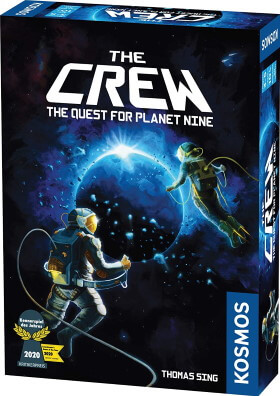
The Crew: The Quest for Planet Nine at a Glance
| Game Type Science Fiction, Card Game, Cooperative, Communication Limits, Trick Taking | Play Time 20 mins | Skill/Complexity (2 - 5) Light |
| Age 10+ | Publisher(s) Kosmos and Others | Published 2019 |
| Categories Family / Strategy | Players 2 - 6 | Cost $21.99 |
| Our Rating 9/10 |
The main idea of The Crew, designed by Thomas Sing, is that players are attempting to complete a series of space-based missions by completing certain tasks for a given mission. There are a total of 50 missions included in the game, which would require potentially multiple sessions in order to complete each one, but it’s possible to play just a few missions with a group if you wish to do so.
At the beginning of a round, players each receive an equal hand of cards from a 40-card deck. Players then take turns drafting task cards from the middle of the table (as indicated in setup for the current mission) in turn order. When a player takes a task card, they place it in front of them. Task cards are small versions of normal cards found in the deck, and in order to complete a task, a player must win a trick containing the card that matches the task card. Different missions have different setup requirements for these tasks, including specific orders in which the tasks must be completed.
Similar to the game The Mind discussed earlier in this list, The Crew does not allow players to communicate regarding what cards are in their hand or what they intend to do on their turn. Players do have communication tokens that they can use once on a mission, which allow them to place a card from their hand face-up for everyone to see, and provides an additional piece of useful information depending on how they place the token on the card (such as whether it is the highest or lowest card of that suite in their hand).
With a relatively quick playtime and small box size, The Crew could be an excellent game to play with friends during lunch break at work, and you could progress through the 50 missions of the game over the course of many days. If you are a fan of trick-taking games or card games in general, The Crew is definitely one to look at.
That’s about it, for now, for our Top 10 Cooperative board games recommendations.
